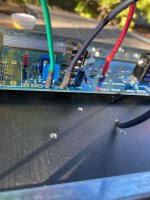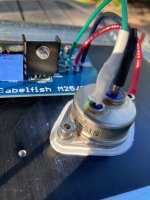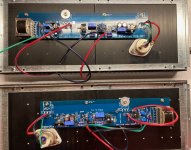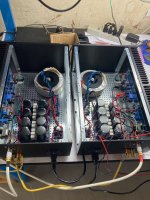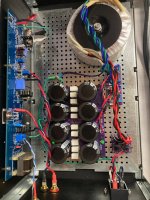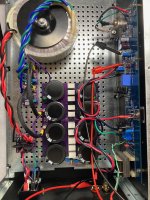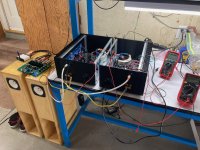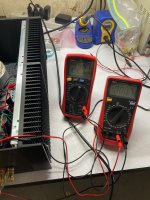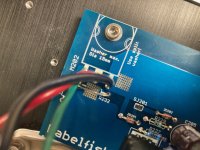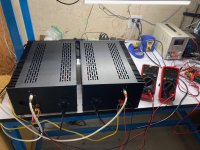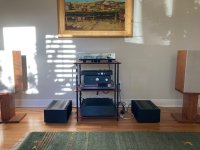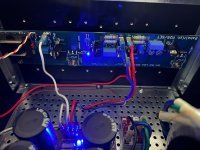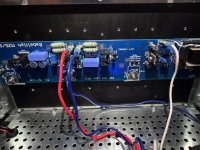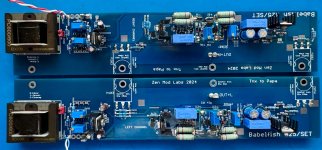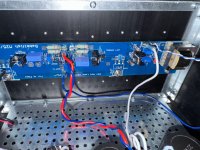Thanks.
I was intrigued by the asymmetric current drive, what you discovered and called upside-down A class, from the M2. I thought the Babelfish M25 circuit was the most direct descendant of that, but I may have gotten lost too. It looks like SissySIT (42) circuit is an identical SIT implementation. Anyway I wanted a circuit that drives a Tokin SIT this way; Papa's final VFET board, the one with MUFF topology, drives the P-VFET asymmetrically too as I understand it, an AC-modulated current source.
So I think the amp boards are done. I'm building these as 4U/400 monoblocks with 200VA donuts, and Randy's CRCRC PS filters.
I was intrigued by the asymmetric current drive, what you discovered and called upside-down A class, from the M2. I thought the Babelfish M25 circuit was the most direct descendant of that, but I may have gotten lost too. It looks like SissySIT (42) circuit is an identical SIT implementation. Anyway I wanted a circuit that drives a Tokin SIT this way; Papa's final VFET board, the one with MUFF topology, drives the P-VFET asymmetrically too as I understand it, an AC-modulated current source.
So I think the amp boards are done. I'm building these as 4U/400 monoblocks with 200VA donuts, and Randy's CRCRC PS filters.
Attachments
It took a while, but I got the Twins to sing.
Multiple assembler errors led to some issues with bias that took me a while, with ZM's help, to get sorted. As an aside, when configuring the right channel of the Babelfish M25 R.2/SET as SissySit (42), be careful not to short the jumper needed in place of R232 to the vias underneath. Doing so will short the gate of the SIT to it's Drain. I'm not sure that's what was happening earlier but I point it out as a potential issue with right channel assembly.
Anyway, I made these using 4U-400 monoblocks which I acquired a while ago, using Randy's Aleph monoblock PSUs for power, and some 200VA Anteks I had left over from another amp.
Final bias when hot is about 2.1A/ch, +/-24V rails, so call it 100Wpc, with DC offset wandering around in the 10mV or less range. This is with 130R level shifters. I should probably use 150R so I can dial in the channels better but I'm calling it good for now. I could easily touch the SITs after an hour of play, they measured 45c by heat gun; the IRFP9140 MOSFET and nearby sink get hotter; estimated as about 60c on the FET itself by heat gun.
This amp definitely bloomed as it got hot. More detail, more thrust, the instrument notes went deeper.
Anyway, finishing these off today was my personal amp camp. If I brought them to Burning Amp tomorrow, would anyone want to put them in their system?
Multiple assembler errors led to some issues with bias that took me a while, with ZM's help, to get sorted. As an aside, when configuring the right channel of the Babelfish M25 R.2/SET as SissySit (42), be careful not to short the jumper needed in place of R232 to the vias underneath. Doing so will short the gate of the SIT to it's Drain. I'm not sure that's what was happening earlier but I point it out as a potential issue with right channel assembly.
Anyway, I made these using 4U-400 monoblocks which I acquired a while ago, using Randy's Aleph monoblock PSUs for power, and some 200VA Anteks I had left over from another amp.
Final bias when hot is about 2.1A/ch, +/-24V rails, so call it 100Wpc, with DC offset wandering around in the 10mV or less range. This is with 130R level shifters. I should probably use 150R so I can dial in the channels better but I'm calling it good for now. I could easily touch the SITs after an hour of play, they measured 45c by heat gun; the IRFP9140 MOSFET and nearby sink get hotter; estimated as about 60c on the FET itself by heat gun.
This amp definitely bloomed as it got hot. More detail, more thrust, the instrument notes went deeper.
Anyway, finishing these off today was my personal amp camp. If I brought them to Burning Amp tomorrow, would anyone want to put them in their system?
Attachments
I should probably use 150R so I can dial in
oh, yes
dialing it down with dissipation will help puny IRFP9140 to live safely
Sizzle and Whoosh
Spent some time backing the bias down to 1.8A when hot, as described elsewhere- much fiddling with level shifters & Iq pots. The DC offset is funny, when these things are cold it's a few hundred milivolts negative, and as the SITs get warm and wake up it goes neutral and then a touch positive, say 20-50mV. It's also funny but the channel that had the harder childhood also reaches DC stability quicker. The wandering offset had me worried but I decided to play it on main, with some watchful observation.
The sound goes from being a touch tight when cold to blooming and forward as it gets hot. I played these immediately after listening to one of Papa's F6's, on a day when I felt like my ears were easy to annoy, and the SITs sound good to me. Sizzle in the treble, and whoosh in the soundstage, is that what y'all mean by spooky? 😊
Spent some time backing the bias down to 1.8A when hot, as described elsewhere- much fiddling with level shifters & Iq pots. The DC offset is funny, when these things are cold it's a few hundred milivolts negative, and as the SITs get warm and wake up it goes neutral and then a touch positive, say 20-50mV. It's also funny but the channel that had the harder childhood also reaches DC stability quicker. The wandering offset had me worried but I decided to play it on main, with some watchful observation.
The sound goes from being a touch tight when cold to blooming and forward as it gets hot. I played these immediately after listening to one of Papa's F6's, on a day when I felt like my ears were easy to annoy, and the SITs sound good to me. Sizzle in the treble, and whoosh in the soundstage, is that what y'all mean by spooky? 😊
Attachments
The wandering offset had me worried but I decided to play it on main, with some watchful observation.
again, nothing to worry about
in general, acceptable figure for all amps, in thermal equilibrium is +/-100mV, as completely normal operationally
now, amps without actual servo action (to keep DC actively controlled) are allowed of greater DC offset span from cold to operational temperature and main criteria is that change of offset is gradual/not abrupt
from my experience , even 750mV can't harm your preciousssssss silver VC Lowther
conclusion - matter of DC Ofset is often overpriced, same as sleep; main thing is that change is gradual and behavior is strictly repetitive (staying in same observed bracket)

Well, I'm still puzzled over this. Why does one channel start at -2V, settle in at about -1V7 after the various time constants have settled, and then drift over the next hour or so to +/- 30mV and stay there, whereas the other bounces around in the 30mV range from the time it's turned on until hours later? I've got DVMs on these things every time I power them up and they're very consistent. As for the grumpy channel, I've taken to waiting until the offset is in the -0V750 range or less, fully warmed up, before I connect that channel's speakers. I am >this close< to putting a speaker protector board in that one channel alone.
This isn't gate leakage, is it? It's got to be some sort of temperature coefficient effect that differs profoundly between the two SITs. The good channel is the one whose SIT saw 8A through it for a few seconds, the bad channel suffered no such insult. I'm to the point of hypothesizing that 8A worth of angry pixies "cleaned out" whatever cruft might have been in the good channel's SIT. I'm not motivated enough to swap SITs as that involves desoldering/dismounting an otherwise working pair of channels, and I don't have a spare pair of ceramic insulators anyway. Electroshock therapy on the bad channel's SIT seems barbaric, so here I am, wondering what this means, and what to do.
This isn't gate leakage, is it? It's got to be some sort of temperature coefficient effect that differs profoundly between the two SITs. The good channel is the one whose SIT saw 8A through it for a few seconds, the bad channel suffered no such insult. I'm to the point of hypothesizing that 8A worth of angry pixies "cleaned out" whatever cruft might have been in the good channel's SIT. I'm not motivated enough to swap SITs as that involves desoldering/dismounting an otherwise working pair of channels, and I don't have a spare pair of ceramic insulators anyway. Electroshock therapy on the bad channel's SIT seems barbaric, so here I am, wondering what this means, and what to do.
I suppose that you tested it with some load at output?
as long these changes are not abrupt, causing punching of speaker cone, nothing to write home about
2Vdc at 8R load ....... that's 0.5W
heat-wise, no problem even for Lowther eeny
again, abrupt changes are what's problematic; gradual and linear changes are not so
yes, SIT gate leakage; biasing mech. and crude output node voltage setting mech. are same on both channels and I can't see what there can drift in a way to explain difference between two channels
now, you know which is only way to confirm or deny that hypothesis
ahem - we can't be sure what stresses happened during assembly and troubleshooting; with electronic parts you always get some unexpected number of dormant Gremlins, and you never know what can pull them from dormancy
with time I realized that my knowledge will never be enough to explain all sorts of malfunctions I dealt with my history as repair tech.
some things I understood, some don't
example - just few days ago I was troubleshooting problematic assembly (made by someone else) of pcbs of one of my amps
I got to plausible explanation what was a root cause of problems, changed some parts to cure that, then changed some parts just for safety (logic) reasons, and then I had problem caused by one of zener diodes, which I just changed
damn thingie even measured OK with basic diode test ( didn't check it with proper zener test fixture) ........ while I just couldn't set Iq with that zd in place
replace it again , and everything works
was it dud ZD, ditto from package of new ones?
dunno, not worth bothering, if another new one is behaving
moral of the rant - checking possibility you (hopefully) get to is often demanding elbow grease; and even when you (hopefully) get to solution, in many cases you can't back-trace what went wrong/what culprit was
bummer with SITs is - replacing actual part with new one is ouch! (*****)
except in case you're having 10K++ critters on the shelf, as one of us is having
old joke, resurrected - ZM and Pa, we are having 12030 SITs on our shelves

***** Luckily - SissySIT is finally developed in way to force even those slightly gate-leaky SITs to behave, with acceptable mischief; try those in basic biasing/offset circuits (as -say - ZM's Red Neck DEFiSIT) , no way
as long these changes are not abrupt, causing punching of speaker cone, nothing to write home about
2Vdc at 8R load ....... that's 0.5W
heat-wise, no problem even for Lowther eeny
again, abrupt changes are what's problematic; gradual and linear changes are not so
yes, SIT gate leakage; biasing mech. and crude output node voltage setting mech. are same on both channels and I can't see what there can drift in a way to explain difference between two channels
now, you know which is only way to confirm or deny that hypothesis
ahem - we can't be sure what stresses happened during assembly and troubleshooting; with electronic parts you always get some unexpected number of dormant Gremlins, and you never know what can pull them from dormancy
with time I realized that my knowledge will never be enough to explain all sorts of malfunctions I dealt with my history as repair tech.
some things I understood, some don't
example - just few days ago I was troubleshooting problematic assembly (made by someone else) of pcbs of one of my amps
I got to plausible explanation what was a root cause of problems, changed some parts to cure that, then changed some parts just for safety (logic) reasons, and then I had problem caused by one of zener diodes, which I just changed
damn thingie even measured OK with basic diode test ( didn't check it with proper zener test fixture) ........ while I just couldn't set Iq with that zd in place
replace it again , and everything works
was it dud ZD, ditto from package of new ones?
dunno, not worth bothering, if another new one is behaving
moral of the rant - checking possibility you (hopefully) get to is often demanding elbow grease; and even when you (hopefully) get to solution, in many cases you can't back-trace what went wrong/what culprit was
bummer with SITs is - replacing actual part with new one is ouch! (*****)
except in case you're having 10K++ critters on the shelf, as one of us is having
old joke, resurrected - ZM and Pa, we are having 12030 SITs on our shelves

***** Luckily - SissySIT is finally developed in way to force even those slightly gate-leaky SITs to behave, with acceptable mischief; try those in basic biasing/offset circuits (as -say - ZM's Red Neck DEFiSIT) , no way
ZM, you were right, powering it up with a speaker load helped, ahem, mightily. It doesn't go much below -1V2 now. It still sounds tight and a little distorted when cold, but who cares, it sounds relaxed and full when warm. This amp made use of an ancient pair of SITs and makes them sing, despite whatever is going on with their temp coefficients or gate leaks. All good.
It still sounds tight and a little distorted when cold
matter of expectations
music in my life is practically ever-present; so, trivial things as amp warm-up time are irrelevant

Another M25/SET - 2024 Iteration (SMD) now singing beautiful tunes.
Replaced an M2x and the sound clarity and definition is pretty stunning, especially when you start to turning up the volume.
With the Square Law OS - as ZM refers, 1.5 amps and 1.8 amps only difference seems to be more heat - sure there is measurable difference, but in terms of listening, simply sounds outstanding, defiantly a nice step up in my main system.
Once I got the Iq in the correct range the Iq and DC Offset are rock solid. Over several days stability is impressive. And, sounds better everyday.
Audio source - DAC into IronPre - version 2 (SMD) into M25/SET (SMD).
Here are some pics for those interested.
Thank you ZM for your attention to every detail and continuing to refine and improve a beautiful sounding power amp. Also, can't appreciate you enough for your patient responses to my questions, education and guidance in building this amp. Why this amp sounds and performs the way it does made much more sense once I started to understand what SET it apart from the "Zillion of other amps." (ZM) 😎
Carl
Replaced an M2x and the sound clarity and definition is pretty stunning, especially when you start to turning up the volume.
With the Square Law OS - as ZM refers, 1.5 amps and 1.8 amps only difference seems to be more heat - sure there is measurable difference, but in terms of listening, simply sounds outstanding, defiantly a nice step up in my main system.
Once I got the Iq in the correct range the Iq and DC Offset are rock solid. Over several days stability is impressive. And, sounds better everyday.
Audio source - DAC into IronPre - version 2 (SMD) into M25/SET (SMD).
Here are some pics for those interested.
Thank you ZM for your attention to every detail and continuing to refine and improve a beautiful sounding power amp. Also, can't appreciate you enough for your patient responses to my questions, education and guidance in building this amp. Why this amp sounds and performs the way it does made much more sense once I started to understand what SET it apart from the "Zillion of other amps." (ZM) 😎
Carl
Attachments
don't do it if you don't have desoldering gun/station
getting those xformer pins desoldered and out, without braking anything, is tricky
I'm doing that always in same manner - first sucking out solder from pads, then pause to let bobbin plastic cool off, and then taking piece of something flat (metal, plastic) to press on all pins at once and push them out
getting those xformer pins desoldered and out, without braking anything, is tricky
I'm doing that always in same manner - first sucking out solder from pads, then pause to let bobbin plastic cool off, and then taking piece of something flat (metal, plastic) to press on all pins at once and push them out
Good tips. I’ve done it once and was success, is a bit stressful. Slow and easy is the only way to get them out. I’ve damaged my share of xformers over the years.
I have both Cinemag and Jensen xformers that I can repurpose. Cinemags also need removal 😱 Will try that out and let you know how it sweetens the pot.
I have both Cinemag and Jensen xformers that I can repurpose. Cinemags also need removal 😱 Will try that out and let you know how it sweetens the pot.
then taking piece of something flat (metal, plastic) to press on all pins at once and push
this is best recipe; if not going inspect to find still soldered pin, if needed reapply solder to that one and suck it out again
that's practically only way to avoid physical stressing of pins in bobbin, and wires are always tight, so prone to breaking
And... Wow, same Cojones, but singing even more sweet and tasty.
told ya
see how clever and beautiful and divine ZM is .............

Appreciate the guidance on removal of xfomer and reinstall.
When Pa gave me this mug, he sez - " Ya must earn it"

Attachments
- Home
- Amplifiers
- Pass Labs
- Babelfish M25 R.2/SET amp
